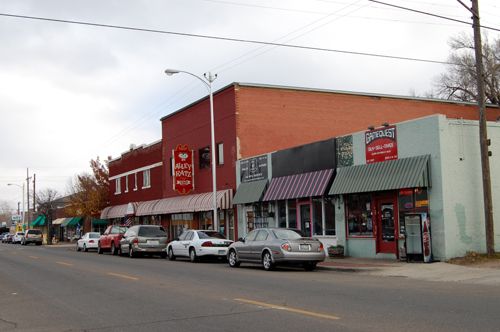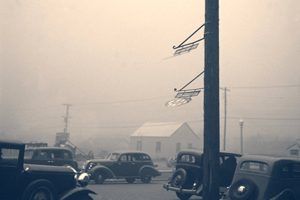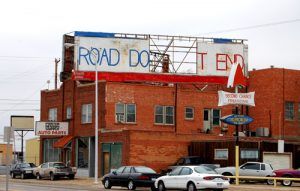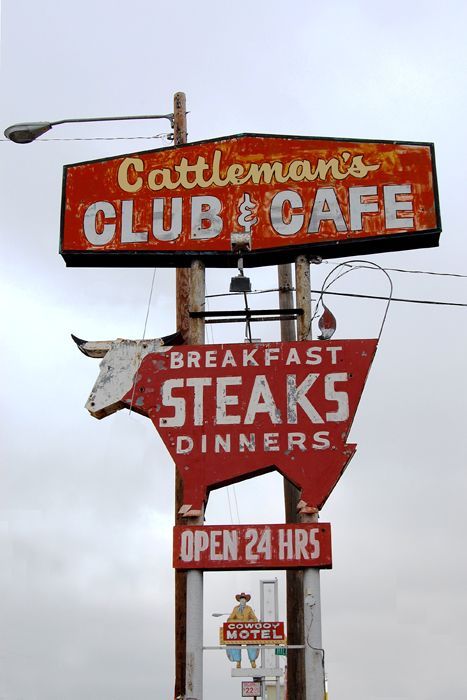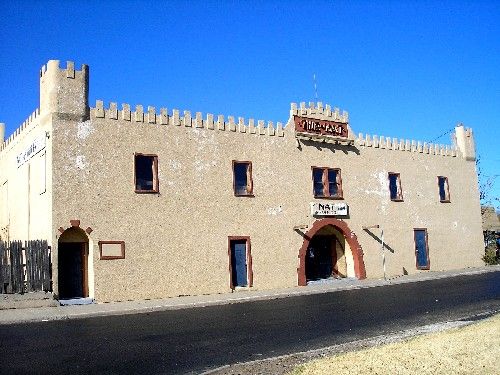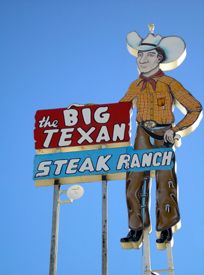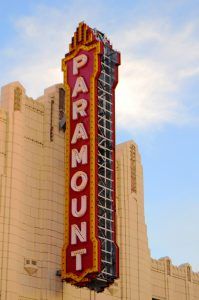Amarillo, Texas, is one of the few places where the Old West is only steps away from a modern 21st-century city surrounded by working ranches that are essentially unchanged from the late 1800s in their day-to-day operations.
Francisco Coronado was the first European to see the vast open spaces of what would one day be the Texas Panhandle – nearly 80 years before the Pilgrims landed at Plymouth Rock. The roving tribes of Indians had dominated the area for centuries and were one of the last strongholds against the invasion of the “White Man.” After the last holdout ended in the Red River War in 1875, the “staked plains” were opened to settlement.
Buffalo hunters immediately sought out the vast, empty territory while the soldiers at Fort Elliott were tasked with keeping the Indians on Oklahoma reservations. In late 1876, Charles Goodnight drove a herd of longhorn cattle into Palo Duro Canyon to begin the first Panhandle ranch. Quickly following, more cattlemen and sheepherders headed to the area for fresh grazing grounds and a place to start a new life.
In 1887 and 1888, two railroads crossed the Panhandle, opening up the former “frontier.” When the Fort Worth and Denver City Railroad came through the area, Amarillo was born as a tent city by railroad workers. J.T. Berry, a townsite developer from Abilene, Texas, quickly began to develop the settlement, and on August 30, 1887, it won the designation as the Potter County seat.
The town was first named “Oneida” but soon changed to Amarillo, meaning “yellow” in Spanish for the soil color on the nearby banks of Amarillo Creek and the abundant yellow wildflowers during the spring and the summer. Most of the town’s first houses were painted yellow to commemorate the name change. The Spanish pronunciation, Ah-mah-ree-yoh, was first used to describe the settlement but was short-lived. As the conductors along the railroad passing through called out their English pronunciation of “Am-ah-rillow,” the beautiful original articulation was lost forever.
Just months after its founding, Amarillo boasted a post office, several stores, a temporary frame courthouse, and soon a 25-room hotel called “The Champion.” In the spring of 1889, when heavy rains almost flooded “Old Town,” most of the settlement moved about one mile east to higher ground.
The first newspaper was founded in 1887, the second in 1889, and the surviving newspaper, the Amarillo News, was founded in 1892. By 1890, Amarillo had emerged as one of the world’s busiest cattle-shipping centers and had grown to a population of nearly 500. Industry in Amarillo thrived in the early years because of railroading, cattle, and merchandising. Amarillo’s population was more than 1,400 by 1900.
By the turn of the century, fencing of ranges began as farmers began to plant wheat, further developing the Amarillo area into a major wheat belt. Construction of the Southern Kansas, the Pecos, and Northern Texas, and the Chicago, Rock Island, and Gulf railroads by 1903 added to the shipping facilities, further increasing the population.
The Amarillo Independent School District was formed in 1905. By the following year, a new stone courthouse and jail were completed after a bitter court battle over ownership of the courthouse square. The Amarillo Street Railway Company began operating its electric streetcar lines in January 1908, and by 1910, Amarillo was called home to almost 10,000 residents. The sudden influx of people with the railroads resulted in the rise of Amarillo’s Bowery district, notorious for its saloons, brothels, and desperados, where crimes were commonplace.
In 1921, a long stretch of Sixth Street became the first paved roadway in Amarillo, a portion of which Route 66 would later follow through the San Jacinto Heights neighborhood. In the earliest days, the route entered Amarillo on 8th Avenue (which later became Amarillo Boulevard,) turned south on Fillmore Street, west on 6th Avenue, and followed Bushland Avenue, leaving the city. Later, as the city expanded, the route was moved entirely to Amarillo Boulevard, bypassing downtown and traveling northwest of much of the city. Numerous service facilities popped up, causing Amarillo Boulevard to be often referred to as “Motel Row.”
The 1930s brought drought and the Dust Bowl to Amarillo, but the decade also saw the rise of tourist stops, numerous motels, and restaurants as Americans began to feverishly travel Route 66.
Today, Amarillo is home to about 300,000 people, where gas, petroleum, agriculture, and cattle are the principal sources of income.
The city also has events and attractions honoring the cowboy and Texas culture, such as Tri-State Fair & Rodeo in September, the World Championship Ranch Rodeo every November, the World Championship Chuckwagon Roundup in June, cattle auctions on Tuesdays.
Other sites include the American Quarter Horse Hall of Fame and Museum, the Don Harrington Discovery Center –an interactive science and space theater, the Kwahadi Museum of the American Indian Art and Culture, and the Amarillo Historical Museum, which features local history.
The Amarillo area is now a major destination for Old West and Route 66 enthusiasts from all over the globe. The lure of the Old West also draws thousands every year to the internationally-famous outdoor musical “Texas” and Cowboy Morning Breakfast, both held at nearby Palo Duro Canyon.
For Route 66 travelers, there are two alignments through the city, both of which begin at east Amarillo Boulevard (US-60/BL-44), which continues to sport several relics of more prosperous times in this now “seedy” looking neighborhood. On the east end of Amarillo Boulevard, look for the old Triangle Motel at 7954 East Amarillo Boulevard on the south side of the road. Across the street is barely recognizable, is an old Whiting Brothers Station. On down the boulevard, look for the vintage sign of the Eastridge Bowling Alley on the north side, the Cattleman’s Club and Cafe, which has been doing business for decades, and the Cowboy Motel next door at 3619 E Amarillo Blvd. Continuing on Amarillo Boulevard, more signs of the vintage Mother Road can be seen, though gradually declining as you move westward.
The original alignment can be accessed by turning south from Amarillo Boulevard onto Pierce Street (US-87), continuing south to 6th Street, and turning west. Several old services continue to stand along this vintage route, though most are not in their original form. The area has returned with numerous old buildings refurbished into antique shops, cafes, and boutiques. Today, this stretch of the old pavement has been designated on the National Register of Historic Places. It has been fashionably restored to an antique district full of collectibles, boutiques, and street-side cafes. A must-see along this route is the Nat Dine and Dance Palace, which once catered to the Big Band Era and later to the rock and rollers of the 1950s. Now a bookstore, it is said to be haunted! Read all about it. Also, look for the Golden Light Bar and Grill along the route and the Broncho Lodge at Bell Street.
While not technically on Route 66 today, the original Big Texan Steak Ranch first stood on Route 66 along East Amarillo Boulevard when the steakhouse was built in 1960. It all began in 1959 when Bob Lee sought a large steak amid “cow country.” To his surprise, Amarillo sported not a single cowboy steak house, which Lee soon began to rectify.
A year later, The Big Texan Steak Ranch opened, claiming to serve the largest steak in Texas. But simply serving the largest steak wasn’t enough; Lee soon began promoting a Free 72-ounce Steak Dinner if customers could eat the whole thing in less than an hour. It wasn’t long before the promotion gained national attention, and travelers thinking of Amarillo immediately associated it with the Texan Steak Ranch, making the restaurant a “must-stop” for travelers of the Mother Road.
When I-40 barreled through Amarillo, bypassing Route 66, Lee moved the restaurant nearer the traffic, but the famous steakhouse retained its reputation as a Mother Road landmark. In addition to its more than 40-year-old steak promotion and seating for 450 in its restaurant, the Big Texan also sports a motel, Old West entertainment, a gift shop, and even a Horse Hotel, all decorated to resemble an Old West town. The Lee family continues to operate the complex, which is lots of fun and provides delicious steak.
In the meantime, keep your eyes open for a series of mock road signs scattered throughout the city collectively called the Dynamite Museum. These signs portray odd bits of philosophy, pictures, and sometimes nonsense. Developed by the eccentric millionaire Stanley Marsh, you can see many pictures of these signs by visiting our Cadillac Ranch and Other Panhandle Oddities page. The article describes the many eccentricities of Stanley Marsh, including the Cadillac Ranch and more.
Also scattered throughout the city are numerous “Horses on Parade,” colorful full-size fiberglass horses painted by local artists, decorate lawns, sidewalks, and building entryways.
Keep right on travelin’ down the Mother Road to the Cadillac Ranch, Vega, and Adrian, Texas.
To stay on the original Mother Road, Amarillo Boulevard will begin to curve back to I-40 when you run into an intersection that is Indian Hills Road (also old Route 66.) Follow this road west toward the old town of Bushland, where the road will end. Rejoining I-40, you can continue on the north frontage road to Vega.
© Kathy Alexander/Legends of America, updated April 2023.
Also See:
Amarillo Air Force Base and Airport
The Cadillac Ranch & Quirky Amarillo
Sources:
Amarillo High School Alumni Association
Amarillo Globe
Amarillo – Step Into the Real Texas
Carlson, Paul Howard; Amarillo: The Story of a Western Town; Texas Tech University Press, 2006.
Visit Amarillo



